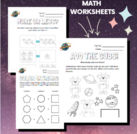
Designed for children from preschool and up. Space theme math worksheets that make learning in the classroom or at home fun.
- Subject:
- Mathematics
- Material Type:
- Homework/Assignment
- Author:
- Cosmic Cubs
- Date Added:
- 03/25/2020

Designed for children from preschool and up. Space theme math worksheets that make learning in the classroom or at home fun.

Designed for children from preschool and up. Space theme math worksheets that make learning in the classroom or at home fun.
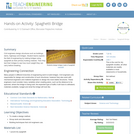
Civil engineers design structures such as buildings, dams, highways and bridges. Student teams explore the field of engineering by making bridges using spaghetti as their primary building material. Then they test their bridges to see how much weight they can carry before breaking.
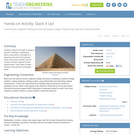
Students analyze and begin to design a pyramid. Working in engineering teams, they perform calculations to determine the area of the pyramid base, stone block volumes, and the number of blocks required for their pyramid base. They make a scaled drawing of the pyramid using graph paper.
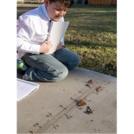
Students will identify which unit of measure inch, foot or yard) is best for measuring various items in the outdoor garden. They will then apply the use of the appropriate tool to measure a variety of objects to the nearest marker.
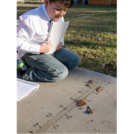
STUDENT ACTIVITY -- 2nd Grade -- TX/GAThis is a distance-learning lesson students can complete at home.Students will identify which unit of measure-inch, foot or yard-is best for measuring various items in the outdoor space. Then, they will use the appropriate tool to measure a variety of objects to the nearest marker.This activity was created by Out Teach (out-teach.org), a nonprofit providing outdoor experiential learning to transform Science education for students in under-served communities.
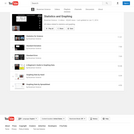
Paul Anderson's video playlist of videos that can be used in a Statistics and Graphing class
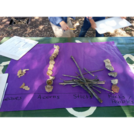
Students will use their knowledge of stem and leaf plots to represent temperature in various locations outdoors.
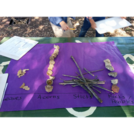
STUDENT ACTIVITY - 4th --TXThis is a distance-learning lesson students can complete at home.The student will use your their knowledge of stem and leaf plots to represent temperature in various locations outdoors.This activity was created by Out Teach (out-teach.org), a nonprofit providing outdoor experiential learning to transform Science education for students in under-served communities.
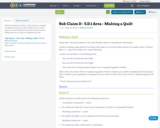
This task requires students to add, subtract, multiply and divide fractions in order to find the area of one square of a quilt. Students must know the formula to finding the area in order to complete this task.
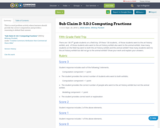
This is a word problem activity where learners should provide the correct computation and provide a reasoning to defend their answer.

This seminar will explore how to solve a system of linear equations using substitution. It will also describe what it means for a system of equations to have no solution or infinitely many solutions. Applications of systems of equations will also be explored.StandardsCC.2.2.HS.D.10Represent, solve, and interpret equations/inequalities and systems of equations/inequalities algebraically and graphically.
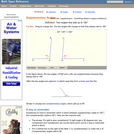
An interactive applet and associated web page that demonstrate supplementary angles (two angles that add to 180 degrees.) The applet shows two angles which, while not adjacent, are drawn to strongly suggest visually that they add to a straight angle. Any point defining the angle scan be dragged, and as you do so, the other angle changes to remain supplementary to the one you change. Applet can be enlarged to full screen size for use with a classroom projector. This resource is a component of the Math Open Reference Interactive Geometry textbook project at http://www.mathopenref.com.

This article provides ideas, lessons and resources on how elementary teachers can integrate map skills, math, and art into lessons about the geography of the Arctic and Antarctica.

This learning video presents an introduction to graph theory through two fun, puzzle-like problems: ''The Seven Bridges of Konigsberg'' and ''The Chinese Postman Problem''. Any high school student in a college-preparatory math class should be able to participate in this lesson. Materials needed include: pen and paper for the students; if possible, printed-out copies of the graphs and image that are used in the module; and a blackboard or equivalent. During this video lesson, students will learn graph theory by finding a route through a city/town/village without crossing the same path twice. They will also learn to determine the length of the shortest route that covers all the roads in a city/town/village. To achieve these two learning objectives, they will use nodes and arcs to create a graph and represent a real problem.
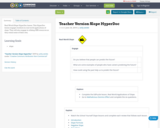
Real World Slope HyperDoc lesson. This HyperDoc lesson engages students in real world applications of slope. They will also engage in utlizing OER resources as they remix some of their own.
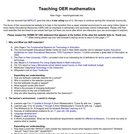
The focus of this website is to help in the transition from a paper oriented environment to one using OER materials with an emphasis in elementary and secondary school mathematics. The website's material is divided into five major topics: 1. Why OER materials? 2. The learner's environment - a world in change. 3. Mathematics past and present. 4. Exploring OER materials and 5. International mathematics education developments. An emphasis has been placed on linking to other OER materials to cover and expand on each topic.
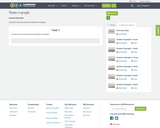
Contains tool overview and student examples

This developmental-level mathematics textbook is intended for career-technical students. The approach is conversational, with many of the examples drawn from everyday life rather than from the technical trades. Practice assignments are available on the MyOpenMath platform.
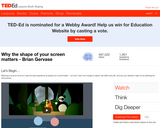
This is a short Ted Talk on similarity unit.